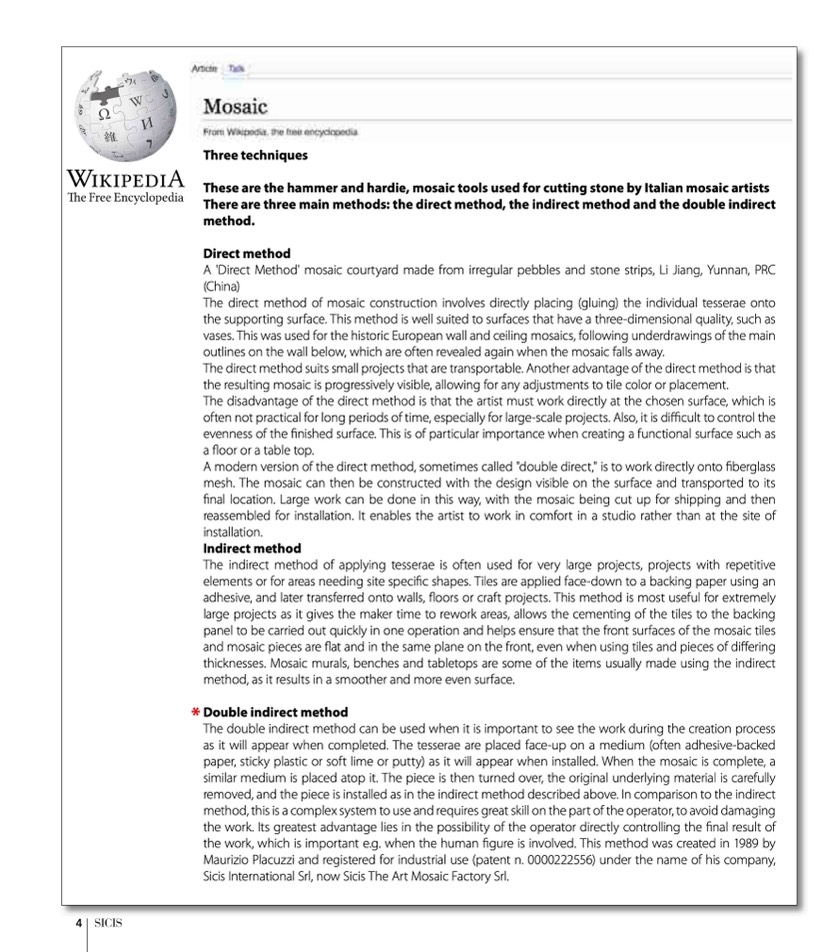
4
Three techniques
These are the hammer and hardie, mosaic tools used for cutting stone by Italian mosaic artists
There are three main methods: the direct method, the indirect method and the double indirect
method.
Direct method
A 'Direct Method' mosaic courtyard made from irregular pebbles and stone strips, Li Jiang, Yunnan, PRC
(China)
The direct method of mosaic construction involves directly placing (gluing) the individual tesserae onto
the supporting surface. This method is well suited to surfaces that have a three-dimensional quality, such as
vases. This was used for the historic European wall and ceiling mosaics, following underdrawings of the main
outlines on the wall below, which are often revealed again when the mosaic falls away.
The direct method suits small projects that are transportable. Another advantage of the direct method is that
the resulting mosaic is progressively visible, allowing for any adjustments to tile color or placement.
The disadvantage of the direct method is that the artist must work directly at the chosen surface, which is
often not practical for long periods of time, especially for large-scale projects. Also, it is difficult to control the
evenness of the finished surface. This is of particular importance when creating a functional surface such as
a floor or a table top.
A modern version of the direct method, sometimes called "double direct," is to work directly onto fiberglass
mesh. The mosaic can then be constructed with the design visible on the surface and transported to its
final location. Large work can be done in this way, with the mosaic being cut up for shipping and then
reassembled for installation. It enables the artist to work in comfort in a studio rather than at the site of
installation.
Indirect method
The indirect method of applying tesserae is often used for very large projects, projects with repetitive
elements or for areas needing site specific shapes. Tiles are applied face-down to a backing paper using an
adhesive, and later transferred onto walls, floors or craft projects. This method is most useful for extremely
large projects as it gives the maker time to rework areas, allows the cementing of the tiles to the backing
panel to be carried out quickly in one operation and helps ensure that the front surfaces of the mosaic tiles
and mosaic pieces are flat and in the same plane on the front, even when using tiles and pieces of differing
thicknesses. Mosaic murals, benches and tabletops are some of the items usually made using the indirect
method, as it results in a smoother and more even surface.
*
Double indirect method
The double indirect method can be used when it is important to see the work during the creation process
as it will appear when completed. The tesserae are placed face-up on a medium (often adhesive-backed
paper, sticky plastic or soft lime or putty) as it will appear when installed. When the mosaic is complete, a
similar medium is placed atop it. The piece is then turned over, the original underlying material is carefully
removed, and the piece is installed as in the indirect method described above. In comparison to the indirect
method, this is a complex system to use and requires great skill on the part of the operator, to avoid damaging
the work. Its greatest advantage lies in the possibility of the operator directly controlling the final result of
the work, which is important e.g. when the human figure is involved. This method was created in 1989 by
Maurizio Placuzzi and registered for industrial use (patent n. 0000222556) under the name of his company,
Sicis International Srl, now Sicis The Art Mosaic Factory Srl.

